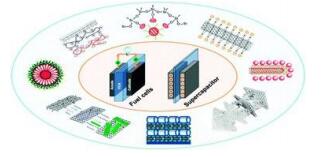摘要:随着科学技术的发展以及人民物质文化生活水平的提高,人们对电池的需求量越来越大, 对电池的性能的要求也越来越高。 锂离子电池作为最有前途的电动汽车的能源之一,其拥有安全性好,循环寿命长和对环境友好等突出的优点。而对于锂离子电池来说,其冲放电性能决定了它的质量的好坏。 除了对于电池的正负极材料的加工工艺和配方比例的不同,其电解液也起着至关重要的作用。本篇论文对于锂离子电池中的电解液酸碱度进行研究,测试多个样品在不同酸碱度下的性能如何。结果表明氢氧化锂,磷酸和硫酸亚铁比例为 1:1.5:2.7 时,电位差随着扫速的增大而增大。而比例为 1:1:3 时,电位差随会着扫速的增加减小。当电解液 PH 值为 4 时,氧化峰和还原峰之间的电位差减小,其 Li 离子脱嵌的能力增强。当PH等于 9 时,电位差增大,电子嵌入脱出能力减弱。35980
毕业论文关键词:锂离子电池;充放电性能;电解液;酸碱度
Effect of pH value on material
Abstract:With the development of science and technology and the improvement of people'smaterial and cultural living standards, demand for quantity and performance of batteries areincreasing.Lithium-ion phosphate battery is one of the most promising candidate power sourcesfor electrical vehicles with the outstanding advantages such as high safety, long cycle life andenvironmentally friendly. As for the lithium-ion battery, its charge and discharge performancedetermines its quality. In addition to processing and formulation proportions of different batterypositive and negative material, electrolyte also plays a vital role. This paper for the lithium-ionbattery electrolyte pH study to test the performance of multiple samples at different pH .Theresults show that lithium hydroxide, phosphate and ferrous sulfate ratio was 1:1.5:2.7,thepotential difference increases with increasing scan rate. The potential difference decreases withthe increase of the sweep rate when the ratio is 1:1:3.When the pH value of electrolyte is 4, thepotential difference between oxidation peak and reduction peak decreases, and the ability of Liion to remove is enhanced.When PH is equal to 9 time, potential difference increases, reducedelectron insertion and extraction ability.
Keywords: Lithium-ion phosphate battery;Charge-discharge performance; electrolyte;pH
目录
1 文献综述1
1.1 课题意义.. 1
1.2 锂离子电池. 1
1.3 锂离子电池的优缺点.. 1
1.3.1 锂离子电池的优点.2
1.3.2 锂离子电池的缺点2
1.4 锂离子电池的发展现状. 3
1.5 锂离子电池的原理及结构 3
1.5.1 锂离子电池原理.3
1.5.2 锂离子电池外形.4
1.5.3 正极材料.4
1.5.4 负极材料.5
1.5.5 磷酸铁锂(LiFePO4).. 5
1.6 电极材料的制备.. 6
1.7 水热法 6
1.8 电化学性能测试——伏安循环测试 7
2 实验仪器与药品8
2.1 实验药品.. 8
2.2 实验仪器.. 8
3 实验过程.12
4 性能测试.14
4.1 XRD检测..14
4.2 同一样品相同酸碱度不同扫速下的比较.. 15
4.3 同一样品相同扫速不同酸碱度的对比 23
4.4 不同样品在相同酸碱度下对比 29
5 结论31
6 展望32
参考文献.33
1 文献综述1.1课题意义能源不仅是人类社会生存和发展的基础,更加是整个世界经济发展的原动力。

(图1.1.1)然而随着人类对能源的开发利用,不可再生资源已经日益减少;而且伴随能源消耗量的不断增长,一系列的环境污染问题已威胁到人类的生存和发展。为解决日趋短缺的能源问题和日益严峻的环境问题, 开发和利用新能源, 做到可持续发展, 是对科学界的挑战,也是对电化学的挑战[1]。 酸碱度对材料的影响:http://www.youerw.com/cailiao/lunwen_34219.html

